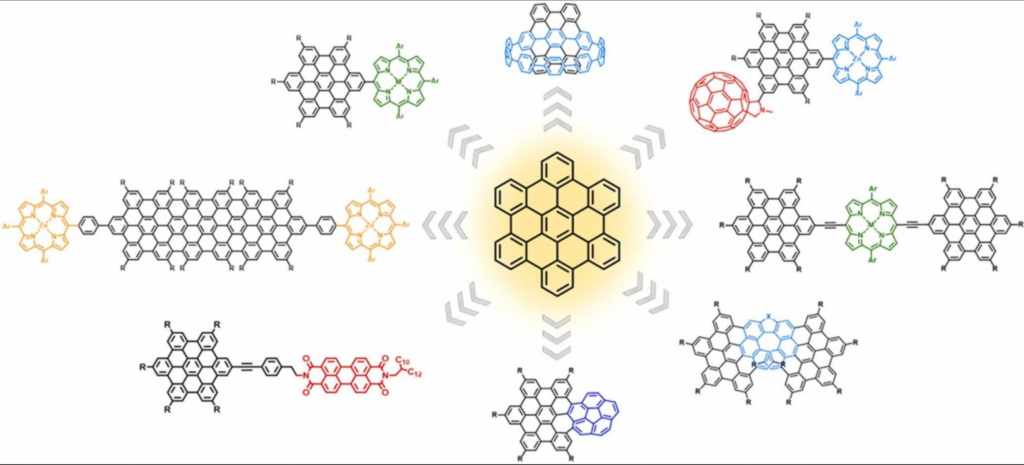Beneventi, G. M., Krug, M., Reger, D., Jux, N., Guldi, D. M., Journal of Photochemistry and Photobiology C: Photochemistry Reviews 2023, 56, 100602. https://doi.org/10.1016/j.jphotochemrev.2023.100602
Bottom-up strategies have allowed the synthesis of “molecular” nanographenes with full control over size, shape and functionality. In recent years, the progress on wet chemical approaches, oxidative cyclodehydrogenation amongst all, has been the foundation to the synthesis of an impressive number of soluble and well-defined molecular nanographenes. The level of control over nanographene syntheses has allowed a fine-tuning of the photophysical and electrochemical properties and, in turn, has a compelling potential in the field of material science. In this regard, understanding and harnessing the competition between electron transfer and energy transfer in nanographenic systems is of utmost importance. However, a comprehensive structure-property relationship remains still an open aspect. In the present review we describe a large variety of hexa-peri-hexabenzocoronene (HBC)-based nanographenes obtained through wet chemical strategies and linked – either covalently or non-covalently – to porphyrins, rylenes, fullerenes, etc. Particular attention was placed on the optical, electrochemical and excited-state properties.
Highlights
- Bottom-up strategies allow synthesis of “molecular” nanographenes with full control over size, shape and functionality.
- Fine-tuning of the photophysical and electrochemical properties of the resulting nanographenes.
- Understanding and harnessing the competition between electron transfer and energy transfer in nanographenic systems is of utmost importance.
- Comprehensive structure-property relationship relationship remains still an open aspect.
- Large variety of hexa-peri-hexabenzocoronene (HBC)-based nanographenes.

Beneventi, G. M., Krug, M., Reger, D., Jux, N., Guldi, D. M., Journal of Photochemistry and Photobiology C: Photochemistry Reviews 2023, 56, 100602. https://doi.org/10.1016/j.jphotochemrev.2023.100602
Bottom-up strategies have allowed the synthesis of “molecular” nanographenes with full control over size, shape and functionality. In recent years, the progress on wet chemical approaches, oxidative cyclodehydrogenation amongst all, has been the foundation to the synthesis of an impressive number of soluble and well-defined molecular nanographenes. The level of control over nanographene syntheses has allowed a fine-tuning of the photophysical and electrochemical properties and, in turn, has a compelling potential in the field of material science. In this regard, understanding and harnessing the competition between electron transfer and energy transfer in nanographenic systems is of utmost importance. However, a comprehensive structure-property relationship remains still an open aspect. In the present review we describe a large variety of hexa-peri-hexabenzocoronene (HBC)-based nanographenes obtained through wet chemical strategies and linked – either covalently or non-covalently – to porphyrins, rylenes, fullerenes, etc. Particular attention was placed on the optical, electrochemical and excited-state properties.
Highlights